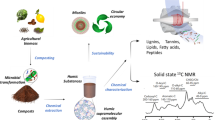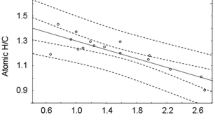Abstract
In-source pyrolysis-field ionization mass spectrometry (Py-FIMS), in combination with complementary elemental, wet-chemical, biochemical, and microbiological data, has been used to characterize humus composition and dynamics in soil samples from several field plots that have been cultivated in long-term experiments under different management conditions.
Thermograms and Py-FI mass spectra of whole-soil samples from field plots that under very different management show significant differences in humus composition, which may be due to varying stages of decomposition of plant residues and humus genesis. The intensity of soil management significantly affects high-molecular-weight subunits such as dimeric lignin0, arylalkyl-, and aliphatic constituents, even though humus quantity is similar for plots under more practically oriented management, such as crop rotation. The differences in molecular humus subunits of soil samples from different plots, in combination with complementary data, demonstrated that less parent (i.e. primary) material is incorporated in the humus matrix under intense soil management conditions. Samples from different field plots can thus be objectively differentiated on the basis of humus properties using multivariate statistical techniques such as principal component and cluster analyses. This statistical discrimination, using Py-FI mass spectra of the samples, corresponds well with microbial biomasses but is somewhat inconsistent with elemental data and results of chemical degradation procedures. The microflora populations in soils under intense management are limited by low availability and/or quality of carbon substrates. The resulting restricted internal nitrogen cycle causes those soils to have a reduced capacity to immobilize N, leading to relative enrichment of heterocyclic nitrogen compounds that are resistant to mineralization.
Similar content being viewed by others
References
Andreux F G, Cerri C C, deP Eduardo B and Choné T 1990 Humus contents and transformations in native and cultivated soils. Sci. Total Environ. 90, 249–265.
Beck T 1989 Einfluß langjährig unterschiedlicher Bewirtschaftungsweisen auf bodenmikrobiologische Eigenschaften. VDLUFA 28/II, 879–892.
Bracewell J M 1971 Characterization of soils by pyrolysis combined with mass spectrometry. Geoderma 6, 163–168.
Bracewell J M and Robertson G W 1987 Characteristics of soil organic matter in temperate soils by Curie-point pyrolysis-mass spectrometry. III. Transformations occurring in surface organic horizons. Geoderma 40, 333–344.
Bratchell N 1989 Cluster analysis. Chemometrics Intell. Lab. Sys. 6, 105–125.
Capriel P, Beck T, Borchert H and Härter P 1990 Relationship between soil aliphatic fraction extracted with supercritical hexane, soil microbial biomass and soil aggregate stability. Soil Sci. Soc. Am. J. 54, 415–420.
Dalal R C and Mayer R J 1986 Long-term trend in fertility of soils under continuous cultivation and cereal cropping in southern Queensland. II. Total organic carbon and its loss from the soil profile. Aust. J. Soil Res. 24, 281–292.
Fisher R A 1936 The use of multiple measurements in taxonomic problems. Ann. Eugenics 7, 179–188.
Follett R F and Schimel D S 1989 Effect of tillage practices on microbial biomass dynamics. Soil Sci. Soc. Am. J. 53, 1091–1096.
Gröblinghoff F F, Haider K and Beck T 1989 Einfluß unterschiedlicher Bodenbewirtschaftungssysteme auf biochemische Stoffumsetzungen. VDLUFA 28/II, 893–908.
Haider K and Schulten H-R 1985 Pyrolysis-field ionization mass spectrometry of lignins, soil humic compounds, and whole soil. J. Anal. Appl. Pyrolysis 8, 167–183.
Harper A M, Duewer D L, Kowalski B R and Fasching J L 1977 ARTHUR and experimental data analysis: The heuristic use of a polyalgorithm. In Chemometrics Theory and Application. Ed. B R Kowalski. pp 14–51. ACS Symp. Ser. 52.
Hayes M H B, MacCarthy P, Malcolm R L and Swift R S 1989 Humic Substances II. In Search of Structure. Wiley, Chichester.
Hempfling R and Schulten H R 1988 Characterization and dynamics of organic compounds in forest humus studied by pyrolysis-gas chromatography/electron impact mass spectrometry and pyrolysis-(high-resolution) field ionization mass spectrometry. J. Anal. Appl. Pyrolysis 13, 319–326.
Hempfling R and Schulten H-R 1990 Chemical characterization of the organic matter in forest soils by Curie-point pyrolysis-GC/MS and pyrolysis0field ionization mass spectrometry. Org. Geochem. 15, 131–145.
Hempfling R and Schulten H-R 1991 Pyrolysis-(gas chromatography/) mass spectrometry of agricultural soils and their humic fractions. Z. Pflanzenernaehr. Bodenkd. 154, 425–430.
Hempfling R, Schulten H-R and Horn R 1990 Relevance of humus composition to the physical/mechanical stability of agricultural soils: A study by direct pyrolysis-mass spectrometry. J. Anal. Appl. Pyrolysis 17, 275–281.
Lattimer R P, Harris R E and Schulten H-R 1989 Mass spectrometry. In Determination of Molecular Weight. Ed. A RCooper. pp 391–412. Wiley, New York.
Malinowski E R and Howery D G 1980 Factor Analysis in Chemistry. Wiley, New York.
Meuzelaar H L C, Haverkamp J and Hileman F D 1982 Pyrolysis-Mass Spectrometry of Recent and Fossil Biomaterials. Elsevier, Amsterdam.
Oades J M, Waters A G, Vasallo A M, Wilson M and Jones G P 1988 Influence of management on the composition of organic matter in a red-brown earth as shown by 13C NMR. Aust. J. Soil Res. 26, 289–299.
Saiz-Jimenez C, Haider K and Meuzelaar H L C 1979 Comparisons of soil organic matter and its fractions by pyrolysis-mass spectrometry. Geoderma 22, 25–37.
Saiz-Jimenez C and deLeeuw J W 1986 Chemical characterization of soil organic matter fractions by analytical pyrolysis-gas chromatography. J. Anal. Appl. Pyrolysis 9, 99–119.
Schimel D S 1986 Carbon and nitrogen turnover in adjacent grassland and cropland ecosystems. Biogeochemistry 2, 345–357.
Schnitzer M and Schulten H-R 1992 A new approach to the analysis of soil organic matter. Soil Sci. Soc. Am. J. (In press).
Schulten H-R 1987 Pyrolysis and soft ionization mass spectrometry of aquatic/terrestrial humic substances and soils. J. Anal. Appl. Pyrolysis 12, 149–186.
Schulten H-R and Leinweber P 1991 Influence of long-term fertilization with farmvard manure on soil organic matter: Characteristics of particle-size fractions. Biol. Fertil. Soils 12, 81–88.
Schulten H-R and Schnitzer M (1992) A contribution to solving the puzzle of the chemical structure of humic substances: Pyrolysis-soft ionization mass spectrometry. Sci. Total Environ. (In press).
Schulten H-R and Schnitzer M 1992 Structural studies on soil humic acids by Curie-point pyrolysis-gas chromatography/mass spectrometry. Soil Sci. (In press).
Schulten H-R, Hempfling R and Zech W 1988 Discriminating horizons in a moder profile by field ionization mass spectrometry and pattern recognition. Geoderma 41, 211–222.
Schulten H-R, Plage B and Schnitzer M 1991 A chemical structure for humic substances. Naturwissenschafter 78, 311–312.
Schulten H-R, Simmleit N and Müller R 1987 High-temperature, high-sensitivity pyrolysis-field ionization mass spectrometry. Anal. Chem. 59, 2903–2908.
Schulten H-R, Hempfling R, Haider K, Gröblinghoff F F, Lüdemann H-D and Fründ R 1990 Characterization of cultivation effects on soil organic matter. Z. Pflanzenernaehr. Bodenkd. 153, 97–105.
Skjemstad J O, Dalal R C and Barron P F 1986 Spectroscopic investigation of cultivation effects on organic matter in Vertisols. Soil Sci. Soc. Am. J. 50, 354–359.
Strebel O, Böttcher J, Eberle M and Aldag R 1988 Quantitative and qualitative Veränderungen in A-Horizonten von Sandböden nach Umwandlung von Dauergrünland in Akkerland. Z. Pflanzenernaehr. Bodenkd. 151, 341–347.
Zelles L, Bai Q Y, Beck T and Beese F 1992 Signature fatty acids in phospholipids and lipopolysaccharides as indicators of microbial biomass and community structure in agricultural soils. Soil Biol. Biochem. (In press).
Author information
Authors and Affiliations
Rights and permissions
About this article
Cite this article
Schulten, HR., Hempfling, R. Influence of agricultural soil management on humus composition and dynamics: Classical and modern analytical techniques. Plant Soil 142, 259–271 (1992). https://doi.org/10.1007/BF00010971
Received:
Issue Date:
DOI: https://doi.org/10.1007/BF00010971




